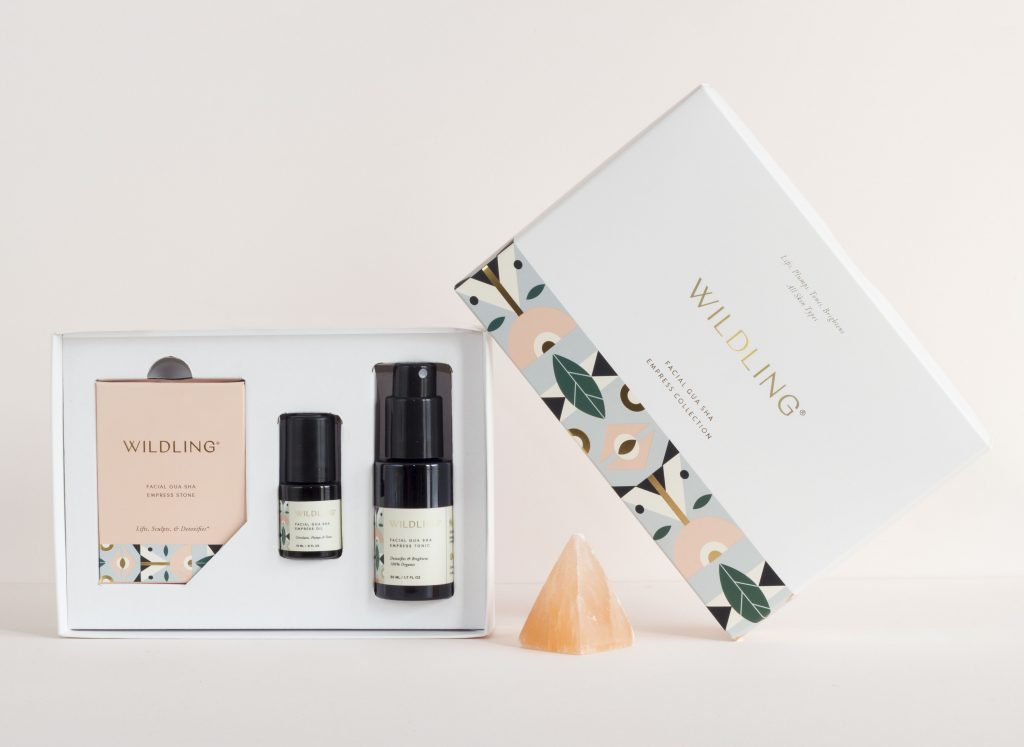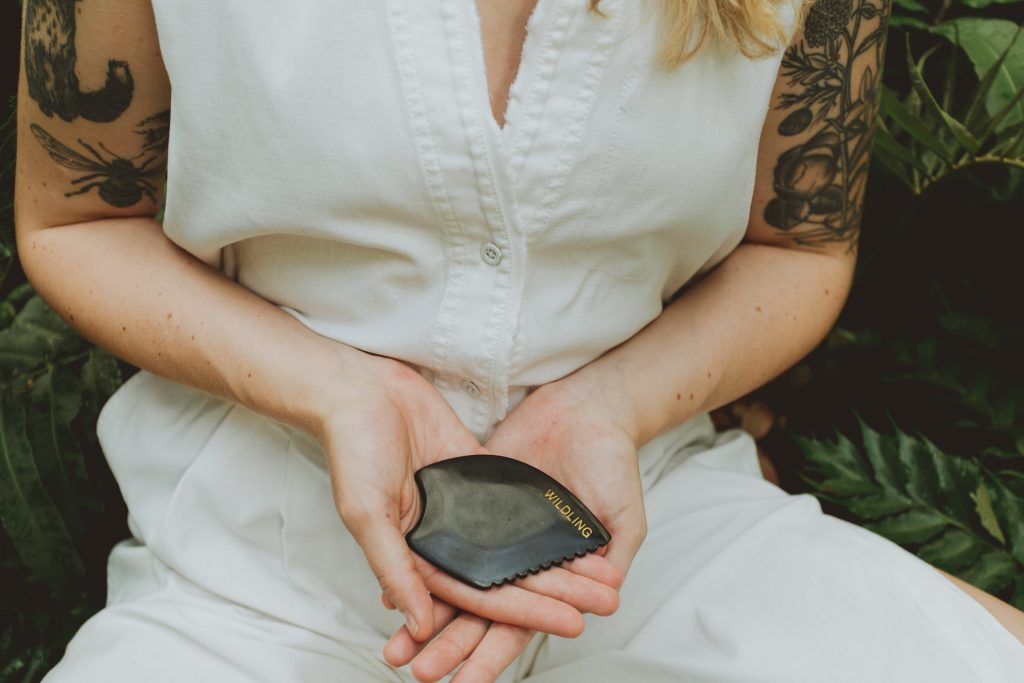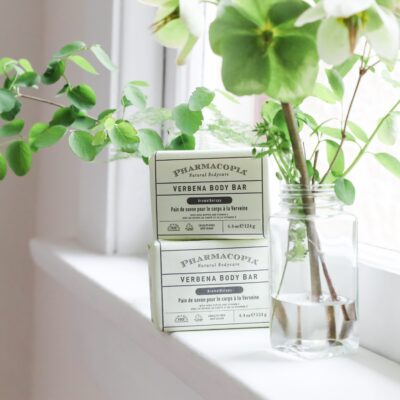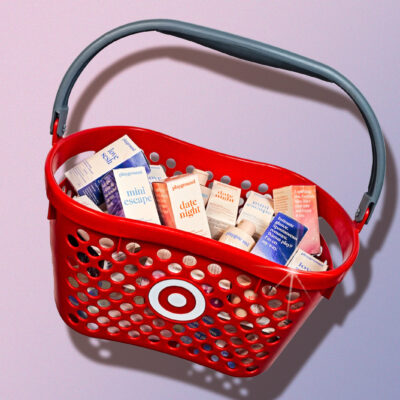
Starting With Gua Sha, Wildling Makes Ancient Modalities Super Stylish For Modern Consumers
About two years ago, Jill Munson, a beauty industry veteran with marketing and product development positions at Josie Maran, SpaRitual, Procter & Gamble and L’Oréal on her resume, attended a gua sha workshop by aesthetician Britta Plug at holistic healing destination AY^AM in Playa del Rey, Calif.
Jade rollers were trendy skincare items, but gua sha wasn’t yet well-known, and the workshop was Munson’s first encounter with it. She was fascinated by the 4,000-year-old Chinese practice that blended beauty and self-care, and Plug’s mesmerizing instruction. It didn’t hurt that the owner of New York facial spa Studio Britta’s ethereal glow was an unbeatable advertisement for gua sha.
“She was teaching this great technique with what was a basic and probably fake jade tool. I approached her and said, ‘This is an amazing technique. What if you created a custom-designed tool that maximized the gua sha effect?’ She said, ‘That sounds amazing, but I’m not a product person.’ I said, ‘I am,’” recounts Munson. “We started it as a small project, but it became something bigger along the way.”
The bigger project is Wildling, a beauty brand that makes an ancient implement eminently contemporary and pairs it with natural skincare products. It took Plug, Munson and Gianna de la Torre, a third partner in the brand and creator of cosmetic acupuncture method Acu·Intuit, a year to perfect Wildling’s patent-pending gua sha from bian stone, which is believed to have been formed in China when meteorites hit the earth 65 million years ago.

“It’s bringing an ancient ritual forward for you as a modern woman to really take care of your skin in the most powerful way possible without having to go the injectable route,” says Munson. “We wanted to bring an alternative that really works for people, and there’s an element of mindfulness to it.”
Called Empress Stone by Wildling, the brand’s gua sha certainly isn’t basic. Its material contains over 40 trace minerals and emits negative ions that amplify anti-aging effects. The facial massage tool has an edge shaped like a “U” to hug curved areas on the face such as the jaw, brow bone and cheeks; a teethed edge to amplify circulation; a tip for acupressure points and knotted regions; a curved edge ideal for the shoulders and neck; and a straight edge equipped for under the chin.
“It’s bringing an ancient ritual forward for you as a modern woman to really take care of your skin in the most powerful way possible without having to go the injectable route.”
Although gua sha tools can be purchased for less than $10 on Amazon, Empress Stone is priced at $65 due to its premium, multifaceted construction. Wildling’s sophisticated packaging incorporating Forest Stewardship Council-certified paper places it an upper-tier merchandise category, too. It has a graphic floral pattern harkening back to folk art.
Skincare tool companies often have difficulty selling topical products they pair with their tools. So far, Wildling hasn’t had that problem. The brand’s $129 Empress Collection combining its gua sha with Empress Tonic and Empress Oil is its bestselling product. Priced invidually at $49, the organic tonic meant to be the initial step of the gua sha ritual features sweet fern, damask rose and douglas fir. The $79 oil has balm of Gilead from buds of the balsam poplar tree; and myrrh, frankincense, guggul and labdanum resin. Wildling relies on local farms for sustainably-foraged wild plants cultivated with fair-trade principles.

“The concept behind the kit is to sell a system to the customer and get people really comfortable with using it altogether. The repeat purchase would be on the products themselves,” says Munson. “We wanted to make it at a price that was accessible to people and could also be good for gifting. It does really well for gifting.”
According to Munson, Wildling’s co-founders invested “a couple hundred thousand” to bring the brand to life. It launched in October last year and, by the summer of this year, it had entered Credo and Free People. For its debut year in business, Wildling’s goal is to reach $500,000 in revenue, but it could cross $1 million. Munson says, “We came into the market at a really great time. The rollers had a moment and, then, we came in with the real deal.”
“The concept of the brand obviously was inspired by gua sha, but it is much more than that.”
To date, Wildling has focused distribution on select retail partners and direct-to-consumer relationships. Munson explains the brand has limited distribution in part because it’s been challenged to keep up with demand, especially since its topical formulas depend on ingredients that aren’t from huge farms with plenty of surplus. She reports Wildling has turned away several retailers as it establishes its operations and following.
Education is paramount for the brand. Plug stars in Wildling’s videos on YouTube, Instagram and its website. “We educate about the stone itself, and why all the shapes and angles are important,” says Munson. Wildling recommends consumers use its gua sha two to three times a week, but greater use can lead to better results. Munson says, “It’s just like yoga. If you go four times a week versus once a week, you are going to see different benefits. If you do something for 21 days straight, it becomes a habit and you see the results.”

Wildling encouraged frequent use with a 21-day gua sha challenge social media campaign. Around 80% of those participating in the challenge revealed they decided to join in to set aside minutes for self-care. Wildling’s core customers are 25- to 35-year-olds interested in wellness. Munson mentions moms-to-be and new moms reconsidering their self-care and skincare routines are significant consumer groups for the brand. Wildling is producing a tutorial about how its tool helps with breastfeeding.
The gua sha tool is just the beginning for Wildling. “The concept of the brand obviously was inspired by gua sha, but it is much more than that,” says Munson. “We will be coming out with another launch in the fall under the gua sha umbrella that will be focused on tension in the face. Then, we will continue to expand to other rituals. There are many traditional modalities that we can bring forward for the modern woman.”





Leave a Reply
You must be logged in to post a comment.